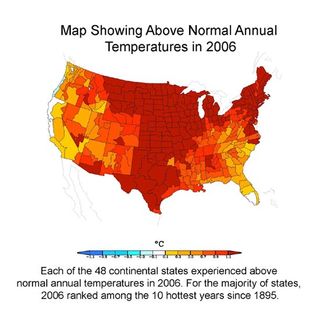Greenhouses Gases Responsible for 2006's Record Warmth

Greenhouse gases were likely responsible for more than half the increase in warmth that smothered the continental United States in 2006, a new study says.
Average yearly temperatures have shown a warming trend in recent decades, but the average temperature of 2006 was the second highest since recordkeeping began in 1895.
The warmest year on record in the United States, 1998, was partly fueled by a very strong El Nino. (El Nino is a warming of the surface waters in the eastern tropical Pacific Ocean that has influence on weather patterns across North America and even into the Atlantic Ocean.)
But unlike 1998, it is unlikely that El Nino influenced the unusual warmth over the continent in 2006, researchers found when they used models to look at the influential factors. They conclude greenhouse gases in Earth's atmosphere increased the probability of U.S. temperatures breaking a record in 2006 by about 15-fold as compared to pre-industrial times.
"We wanted to find out whether it was pure coincidence that the two warmest years on record both coincided with El Nino events," said study leader Martin Hoerling of the National Oceanic and Atmospheric Administration (NOAA) in Boulder, Co. "We decided to quantify the impact of El Nino and compare it to the human influence on temperatures through greenhouse gases."
To tease out the role that greenhouse gases played in the record-breaking warmth, the researchers analyzed simulations of Earth's climate from 18 of the climate models used in the latest Intergovernmental Panel on Climate Change assessment.
Their results, detailed in the Sept. 5 issue of the journal Geophysical Research Letters: Greenhouse gases generated warmth in the model over the entire United States that closely matched the warming pattern actually observed last year, but projections of an El Nino did not.
Sign up for the Live Science daily newsletter now
Get the world’s most fascinating discoveries delivered straight to your inbox.
2006 was originally estimated to be the warmest year on record in the United States according to NOAA, but in May 2007, the ranking was revised to show that 2006 was 0.08 degrees Fahrenheit cooler than 1998.
The annual average for 2006 was 2.1 degrees Fahrenheit above the average for the 20th century and marked the ninth consecutive year of above-normal annual temperatures. For most of the contiguous 48 states, 2006 ranked among the 10 hottest years since 1895.
The researchers estimate there is a 16 percent chance that 2007 will also bring record-breaking warmth, once the data for the rest of the year comes in.
- Video: Goldilocks and the Greenhouse
- Timeline: The Frightening Future of Earth
- Record Warm Year for U.S. in 2006

Andrea Thompson is an associate editor at Scientific American, where she covers sustainability, energy and the environment. Prior to that, she was a senior writer covering climate science at Climate Central and a reporter and editor at Live Science, where she primarily covered Earth science and the environment. She holds a graduate degree in science health and environmental reporting from New York University, as well as a bachelor of science and and masters of science in atmospheric chemistry from the Georgia Institute of Technology.
